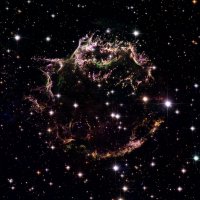Cassiopeia A - The colourful aftermath of a violent stellar death [heic0609]
30 August 2006
A new image taken with the NASA/ESA Hubble Space Telescope provides a detailed look at the tattered remains of a supernova explosion known as Cassiopeia A (Cas A). It is the youngest known remnant from a supernova explosion in the Milky Way. The new Hubble image shows the complex and intricate structure of the star's shattered fragments.
 |
|
Composite ACS image of supernova remnant Cassiopeia A |
A supernova such as the one that resulted in Cas A is the explosive demise of a massive star that collapses under the weight of its own gravity. The collapsed star then blows its outer layers into space in an explosion that can briefly outshine its entire parent galaxy. Cas A is relatively young, estimated to be only about 340 years old. Hubble has observed it on several occasions to look for changes in the rapidly expanding filaments.
In the latest observing campaign, two sets of images were taken, separated by nine months. Even in that short time, Hubble's razor-sharp images can observe the expansion of the remnant. Comparison of the two image sets shows that a faint stream of debris seen along the upper left side of the remnant is moving with high speed - up to 50 million kilometres per hour (fast enough to travel from Earth to the Moon in 30 seconds!).
Cas A is located ten thousand light-years away from Earth in the constellation of Cassiopeia. Supernova explosions are the main source of elements more complex than oxygen, which are forged in the extreme conditions produced in these events. The analysis of such a nearby, relatively young and fresh example is extremely helpful in understanding the evolution of the Universe.
# # #
Notes for editors
The Hubble Space Telescope is a project of international cooperation between ESA and NASA.
Image credit: NASA, ESA, and the Hubble Heritage (STScI/AURA)-ESA/Hubble Collaboration
Acknowledgements: Robert A. Fesen (Dartmouth College, USA) and James Long (ESA/Hubble)
Contacts
Robert A. Fesen
Dartmouth College, Hanover, New Hampshire, USA
Tel: +1-603-646-2949
E-mail: fesen snr.dartmouth.edu
snr.dartmouth.edu
Lars Lindberg Christensen
Hubble/ESA, Garching, Germany
Tel: +49-(0)89-3200-6306
Cellular: +49-(0)173-3872-621
E-mail: lars eso.org
eso.org
Ray Villard
Space Telescope Science Institute, Baltimore, USA
Tel: +1-410-338-4514
E-mail: villard stsci.edu
stsci.edu
Keith Noll
Space Telescope Science Institute, Baltimore, USA
Tel: +1-410-338-1828
E-mail: noll stsci.edu
stsci.edu


